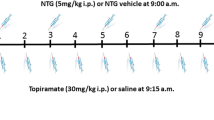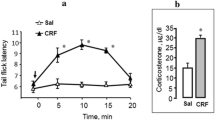Abstract
1.In rats, injection of mustard oil (MO) into the paw caused a gradual increase in flinching of the injected paw and this algogenic behavior corresponded with an increase in the CSF-Glu level.
2.The nerve growth factor (NGF) inducer, 4-methyl catechol (4MC), enhanced the frequency of flinching and this effect was dose dependent. In addition, spinal CSF-Glu release was significantly above baseline 10 min after MO injection. In contrast, morphine (MOR) pretreatment completely blocked this behavioral and neurohumoral effect.
3.Anti-NGF paw injection attenuated the algogenic behavior and spinal Glu release otherwise observed after 4MC treatment.
4.The results demonstrated that MO-induced hyperalgesia is associated with increased CSF-Glu release and that this effect is potentiated by a NGF inducer. These data also suggest a possible involvement of NGF in the development of central sensitization after acute peripheral nociceptive stimulation.
Similar content being viewed by others
REFERENCES
Chen, L., and Huang L. Y. M. (1992). Protein kinase C reduces Mg2+ block of NMDA-receptor channels as a mechanism of modulation. Nature 356:521–523.
Coderre, T. J., Katz, J., Vacarrino, A. L., and Melzack, R. (1993). Contribution of central neuroplasticity to pathological pain: review of clinical and experimental evidence. Pain 52:259–285.
Crowley, C., Spencer, S. D., Nishimura, M. C., Chen, K. S., Pitts-Meek, S., Armanini, M. P., Ling, L. H., MacMahon, S. B., Shelton, D. L., and Levinson, A. D. (1994). Mice lacking nerve growth factor display perinatal loss of sensory and sympathetic neurons yet develop basal forebrain cholinergic neurons. Cell 76:1001–1011.
Dikenson, A. H., and Sullivan, A. F. (1987). Evidence for a role the NMDA receptor in the frequency dependent potentiation of deep rat dorsal horn nociceptive neurons following C fibre stimulation. Neuropharmacology 26:1235–1238.
Donnerer, J., Sculigoi, R., and Stein, C. (1992). Increased content and transport of substance P and calcitonin gene-related peptide in sensory nerves innervating inflamed tissue: Evidence for a regulatory function of nerve growth factor in vivo. Neuroscience 49:693–698.
Ehrhard, P. B., Erb, P., Graumann, U., Schmutz, B., and Otten, U. (1993). Expression of nerve growth factor and nerve growth factor receptor tyrosine kinase Trk in activated CD4-positive T-cell clones. Proc. Natl. Acad. Sci. USA 90:10984–10988.
Franklin, R. A., Brodie, C., Melamed, I., Terada, N., Lucas, J. J., and Gelfand, E. W. (1995). Nerve growth factor induces activation of MAP-kinase and p90rsk in human B lymphocytes. J. Immunol. 154:4965–4972.
Furukawa, S., and Furukawa, Y. (1990). Nerve growth factor synthesis and its regulatory mechanisms: An approach to theraperutic induction of nerve growth factor synthesis. Cerebrovasc. Brain Metab. Rev. 2:328–344.
Furukawa, Y., Furukawa, S., Satoyoshi, E., and Hayashi, K. (1989). Catecholamines increase nerve growth factor mRNA contents in both mouse astroglial cells and fibroblasts cells. FEBS Lett. 247:463–467.
Gandhi, V. C., and Jones, D. J. (1992). Protein kinase C modulates the release of [3H] 5-hydroxytryptamine in the spinal cord of the rat—The role of L-type voltage-dependent calcium channels. Neuropharmacology 31:1101–1109.
Go, V. L. W., and Yaksh, T. L. (1987). Release of substance P from the cat spinal cord. J. Physiol. 391:141–167.
Heumann, R., Korsching, S., Bandtlow, C., and Thoenen, H. (1987a). Changes of nerve growth factor synthesis in non-neuronal cells in response to sciatic nerve transection. J. Cell. Biol. 104:1623–1631.
Heumann, R., Lindholm, D., Bandtlow, C., Meyer, M., Radeke, M., Misko, T, and Shooter, E. and Thoenen H. (1987b). Differential regulation of mRNA encoding nerve growth factor and its receptor in rat sciatic nerve during development, degeneration, and regeneration. Role of macrophages. Proc. Natl. Acad. Sci. USA 84:8735–8739.
Horigome, K., Bullock, E. D., and Johnson, E. M., Jr. (1994). Effects of nerve growth factor on rat peritoneal mast cells. Survival promotion and immediate-early gene induction. J. Biol. Chem. 269:2695–2702.
Ikegami, R., Furukawa, Y., Kaechi, K., Hayashi, K., and Furukawa, S. (1990). Effects of catecholamines and 4-methylcatechol on the synthesis and secretion of nerve growth factor by rat sciatic nerve segments in culture. Biomed. Res. 11:61–65.
Ishikawa, R., Nishikori, K., and Furukawa, S. (1991). Appearance of nerve growth factor and acidic fibroblast growth factor with different time courses in the cavity-lesioned cortex of the brain. Neurosci. Lett. 127:70–72.
Leon, A., Buriani, A., Dal-Toso, R., Fabris, M., Romanello, S., Aloe, L., and Levi-Montalcini, R. (1994). Mast cells synthesize, store, and release nerve growth factor. Proc. Natl. Acad. Sci. USA 91:3739–3743.
Lewin, G. R., and Mendell, L. M. (1993). Nerve growth factor and nociception. TINS 16:353–359.
Lindholm, D., Heumann, R., Meyer, M., and thoenen, H. (1987). Interleukin-1 regulated synthesis of nerve growth factor in non-neuronal cells of rat sciatic nerve. Nature 330:658–659.
Lindholm, D., Heumann, R., Hengerer, B., and Thoenen, H. (1988). Interleukin-1 increases stability and transcription of mRNA encoding nerve growth factor in cultured rat fibroblasts. J. Biol. Chem. 263:16348–16351.
Malmberg, A. B., and Yaksh, T. L. (1993). Pharmacology of the spinal action of ketrolac, morphine, ST-91, U50488H, and L-PIA on the formalin test and in isobolographic analysis of the NSAID interaction. Anesthesiology 79:270–281.
Malmberg, A. B., and Yaksh, T. L. (1994). Voltage-sensitive calcium channels in spinal nociceptive processing: Blockade of N-and P-type channels inhibits formalin-induced nociception. J. Neurosci. 14:4882–4890.
Marsala, M., Malmberg, A. B., and Yaksh, T. L. (1995). The spinal loop dialysis catheter: Characterization of use in the unanesthetized rat. J. Neurosci. Methods 62:43–53.
Melamed, I., Kelleher, C. A., Franklin, R. A., Brodie, C., Hempstead, B., Kaplan, D., and Gelfand, E. W. (1992). Nerve growth factor signal transduction in human B lymphocytes is mediated by gp140trk. Eur. J. Immunol. 26:1985–1992.
Meller, S. T., and Gebhart, G. F. (1993). Nitric oxide (NO) and nociceptive processing in the spinal cord. Pain 52:127–136.
Nagy, I., Maggi, C. A., Dray, A., Woolf, C. J., and Urban, L. (1993). The role of neurokinin and NMDA receptors in synaptic transmission from capsaicin-sensitive primary afferents in the rat spinal cord in vitro. Neuroscience 52:1029–1037.
Silos-Santiago, I., Molliver, D. C., Ozaki, S., Smeyne, R. J., Fagan, A. M., Barbacid M., and Snider, W. D. (1995). Non-TrkA-expressing small DRG neurons are lost in TrkA deficient mice. J. Neurosci. 15:5929–5942.
Simonds, W. F. (1988). The molecular basis of opioid receptor function. Endocr. Rev. 9:200–212.
Skingle, M., Hayes, A. G., and Tyers, M. B. (1982). Antinociceptive activity of clonidine in the mouse, rat, and dog. Life Sci. 31:1123–1132.
Snider, W. D. (1994). Functions of the neurotrophins during nervous system development: What the knockouts are teaching us. Cell 77:627–638.
Sweeney, M. I., White, T. D., Jhamandas, K. H., and Sawynok, J. (1987). Morphine releases endogenous adenosine from the spinal cord in vivo. Eur. J. Pharmacol. 141:169–170.
Thoenen, H., and Barde, Y. A. (1980). Physiology of nerve growth factor. Physiol. Rev. 60:1284–1335.
Urban, L., Tompson, S. W., and Dray, A. (1994). Modulation of spinal excitability: Co-operation between neurokinin and excitatory amino acid neurotransmitters. TINS 17:432–438.
Wheeler-Aceto, H., Frank, P., and Alan, C. (1990). The rat paw formalin test: Comparison of noxious agents. Pain 40:229–238.
Worley, P. F., Baraban, J. M., and Synder, S. H. (1986). Heterogeneous localization of protein kinase C in rat brain: Autoradiographic analysis of phorbol ester receptor or binding. J. Neurosci. 6:199–207.
Yaksh, T. L., and Rudy, T. A. (1976). Chronic catheterization of the spinal subarachnoid space. Physiol. Behav. 17:1031–1036.
Author information
Authors and Affiliations
Rights and permissions
About this article
Cite this article
Ishikawa, T., Nakanishi, O., Funatsu, N. et al. Nerve Growth Factor Inducer, 4-Methyl Catechol, Potentiates Central Sensitization Associated with Acceleration of Spinal Glutamate Release After Mustard Oil Paw Injection in Rats. Cell Mol Neurobiol 19, 587–596 (1999). https://doi.org/10.1023/A:1006928317312
Issue Date:
DOI: https://doi.org/10.1023/A:1006928317312




